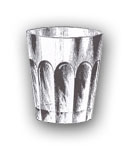
If you went thirsty while visiting the Exposition,
you had no one to blame but yourself! From $5.00 ($102.14)
bottles of Mumm's Extra Dry champagne to free water from the first drinking
'fountains', visitors had a spectrum of beverages that were both familiar
and new.
Mineral & Spring Waters
Enjoying popularity in 1901 were numerous varieties of mineral waters which
included 'ginger ales.' These were promoted for their health benefits, despite
the fact that you were served the water in a glass which was then briefly
rinsed and used to serve the next customer. Paper cups, a major improvement
in public sanitation, would not be developed for another 7 years. Some examples
of waters you could purchase were Appollinaris, $.25 ($5.11)
a pint; White Rock, $.20 ($4.09) a pint;
Crystal Lithia Water, $.05 ($1.02) a half-pint;
Crystal Water Company's Ginger Ale, $.05 a half-pint; Vartra Ginger Ale,
$.20 a pint; Imported C & C Ginger Ale, $.25 a pint.
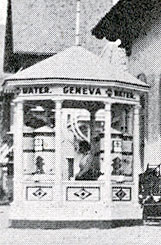 The
Saratoga Springs Mineral Water Company had its own stand on the grounds
near the state and foreign buildings, or you could visit their booth in
the Manufactures & Liberal Arts Building for a free sample. Competing
companies in that building also serving free samples of mineral waters were
the Arethusa Spring Water Company (Connecticut), the Consumer's Company
(Chicago), Geneva Mineral Water Company (Brookyn, "Perfectly pure.
Pleasantly practical."), Mohican Spring Water Company (Newark, New
Jersey). The
Saratoga Springs Mineral Water Company had its own stand on the grounds
near the state and foreign buildings, or you could visit their booth in
the Manufactures & Liberal Arts Building for a free sample. Competing
companies in that building also serving free samples of mineral waters were
the Arethusa Spring Water Company (Connecticut), the Consumer's Company
(Chicago), Geneva Mineral Water Company (Brookyn, "Perfectly pure.
Pleasantly practical."), Mohican Spring Water Company (Newark, New
Jersey).
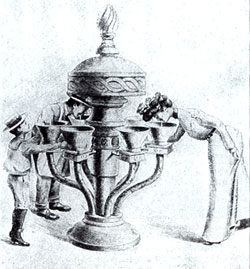 Just
Plain Water Just
Plain Water
If you only wanted a drink of water to get the dust of the grounds out of
your throat, you could be one of the first to use the new drinking fountain
invention, located in the corners of the Manufactures Building. For the
first time, public water facilities would no longer force people to share
a common dipper, a practice believed to be unsanitary. A stream of water
was presented upon demand to the thirsty person who could then imbibe it
in a hands-free manner.
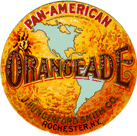 Soft
Drinks - Fruit Juices & Carbonated Beverages Soft
Drinks - Fruit Juices & Carbonated Beverages
Concessions around the grounds sold "Pan-American Orangeade" for
5 cents which had been available for decades and was made, like all fruit
juice drinks of the time, by boiling fruit juice with water and sugar to
make a syrup. One recipe used 1/2 cup juice, 1 pint water, and 1 cup sugar
to make the syrup which was then poured over crushed ice. A prominent vendor
of orangeade was J Hungerford Smith, a company based in Rochester, New York.
The company began in 1879, and was to absorb the A & W Root Beer Company
for a time. In 2001, the JHS company, now part of ConAgra foods, still manufacturers
'orange slush' base for drinks. Buffalo Concessions had the soft drink concessions
on the grounds. They charged $.05 ($1.02) for a
glass of orangeade, the same price as in the city, they said.
Other concessions sold apple cider (probably
fresh-made locally) and you could buy Grapeine (unknown composition) and
Welch's Unfermented Grape Juice at 5 cents a glass in the Horticulture Building.
If you could hold your thirst until you reached the Manufactures' Builidng,
you could sample Welch's grape juice for free along with three other brands.
Also widely available were carbonated beverages
which fit into the generic classification used in 2001 of "root beer."
Sarsafareine was created probably from sarsaparilla (from the roots of the
smilax bush) with sassafrass root added for flavor.
Hot Beverages
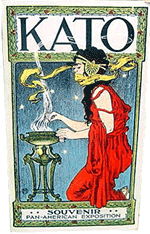 If you visited
the Exposition in May or October, you would need a warm beverage after a
few hours on the chilly, breezy grounds. The Bailey Catering Company restaurants
were selling coffee at $.10 ($2.00) a cup.
You could get samples of coffee in the Manufactures' Building and also taste
the first 'instant' coffee introduced there by the Kato Coffee Company of
Chicago. If you visited
the Exposition in May or October, you would need a warm beverage after a
few hours on the chilly, breezy grounds. The Bailey Catering Company restaurants
were selling coffee at $.10 ($2.00) a cup.
You could get samples of coffee in the Manufactures' Building and also taste
the first 'instant' coffee introduced there by the Kato Coffee Company of
Chicago.
If you were a chocolate lover, you could
visit the Lowney Building or the Baker's Chocolate
Building to enjoy $.05 ($1.00) hot chocolate.
Although Americans consumed ony a third of a pound of chocolate per person
in 1900, its popularity was growing with American incomes. (In 2001, Americans
consume nearly 10 pounds per person.)
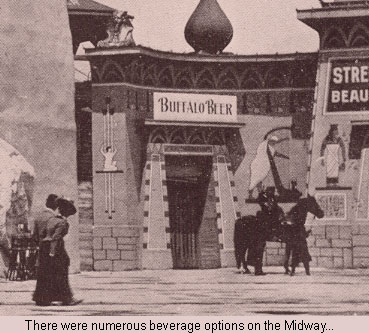 Beer
and Hard Liquor Beer
and Hard Liquor
If Americans had one beverage of choice in 1900, it would be beer. They
consumed it throughout their work day, at meals and during convivial gatherings.
The amount consumed per person was 17.73 gallons (vs. 23.95 gallons in 2000).
It was only natural that beer be sold on the Exposition grounds as part
of restaurant concessions. The Pabst Brewery of Milwaukee, Wisconsin, maintained
a large concession in the heart of the Midway. The Pabst
Pavilion, at the corner of the North and South Midway, offered musical
accompaniment to the standard menu of the times.
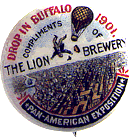
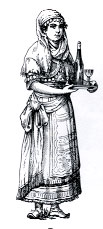
|

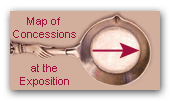

 The
Saratoga Springs Mineral Water Company had its own stand on the grounds
near the state and foreign buildings, or you could visit their booth in
the Manufactures & Liberal Arts Building for a free sample. Competing
companies in that building also serving free samples of mineral waters were
the Arethusa Spring Water Company (Connecticut), the Consumer's Company
(Chicago), Geneva Mineral Water Company (Brookyn, "Perfectly pure.
Pleasantly practical."), Mohican Spring Water Company (Newark, New
Jersey).
The
Saratoga Springs Mineral Water Company had its own stand on the grounds
near the state and foreign buildings, or you could visit their booth in
the Manufactures & Liberal Arts Building for a free sample. Competing
companies in that building also serving free samples of mineral waters were
the Arethusa Spring Water Company (Connecticut), the Consumer's Company
(Chicago), Geneva Mineral Water Company (Brookyn, "Perfectly pure.
Pleasantly practical."), Mohican Spring Water Company (Newark, New
Jersey).  Just
Plain Water
Just
Plain Water Soft
Drinks - Fruit Juices & Carbonated Beverages
Soft
Drinks - Fruit Juices & Carbonated Beverages If you visited
the Exposition in May or October, you would need a warm beverage after a
few hours on the chilly, breezy grounds. The Bailey Catering Company restaurants
were selling coffee at $.10 (
If you visited
the Exposition in May or October, you would need a warm beverage after a
few hours on the chilly, breezy grounds. The Bailey Catering Company restaurants
were selling coffee at $.10 ( Beer
and Hard Liquor
Beer
and Hard Liquor
